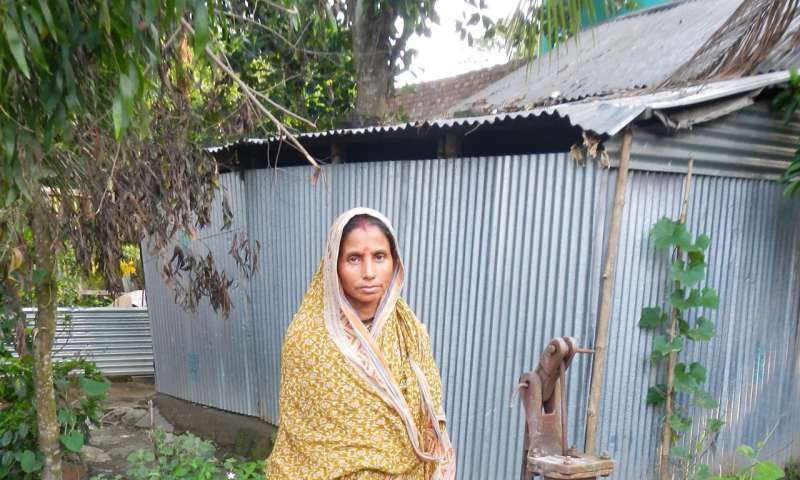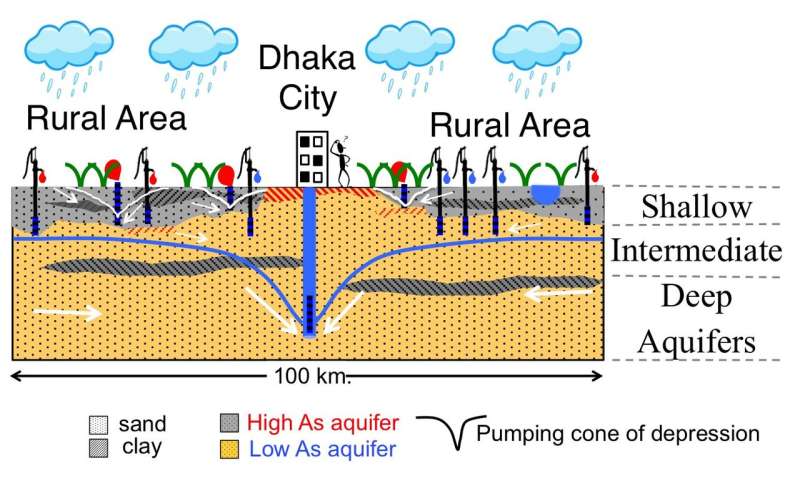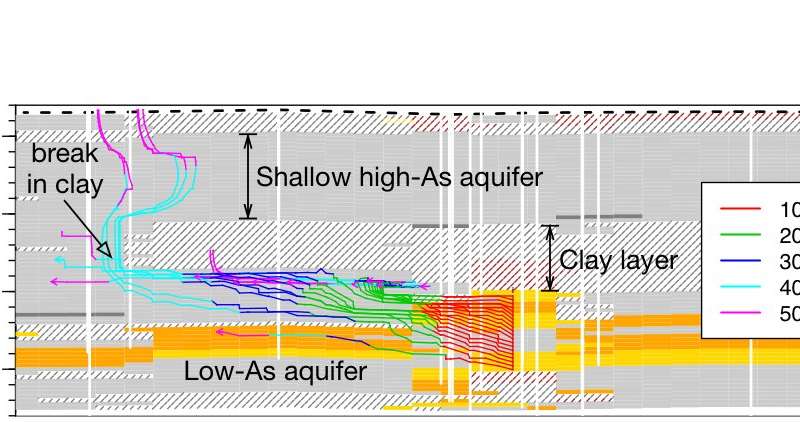Origin of arsenic in Bangladesh groundwater

Twenty years ago, Smith and colleagues described groundwater arsenic (As) contamination in Bangladesh as the "largest mass poisoning of a population in history." An estimated 60 million people were unknowingly drinking groundwater containing dangerous concentrations of naturally occurring As. Today, despite a much-improved well water testing effort, an estimated 30–35 million are still chronically exposed to elevated levels of As in their drinking water, and hundreds of thousands are suffering from cardiovascular disease and cancers, leading to a staggering annual estimated death toll of 43,000.
We studied a rural area in Bangladesh where the villagers reduced their exposure to As over the past decade largely through installation of private wells at >50 m depth within a sandy, low-As aquifer. The low-As aquifer is seemingly protected from the intrusion of shallower (<50 m), high-As groundwater because a thick, low permeability clay layer acts as a barrier between them. We show that groundwater overpumping in the megacity of Dhaka, located 25 km west of the study area, has threatened the sustainability of the low-As aquifer in this particular region.
Impact of a growing cone of depression
Pumping lowers groundwater heads and creates concentric patterns of water level drawdown, collectively known as the "cone of depression." When groundwater is pumped at a rate higher than the rate of replenishment, the cone of depression formed at the pumping center starts to grow radially outward over time as more water is drawn in from surrounding areas. In Dhaka, a city of 21 million people, the deep aquifer (>150 m) has been overexploited over the last 50 years to meet municipal demands. The Dhaka cone of depression has already expanded 30–40 km outside the city center, drawing water from beyond the city limits and lowering heads in distant rural aquifers.
Our field data show that the deep hydraulic head decline in the pumping center of Dhaka at a rate of >3 m/year is causing the head to decline by ~0.5 m/year at our study site in rural Araihazar. Water levels in the shallow aquifer (<50 m) of Araihazar, however, are stable (beyond seasonal fluctuations) over time due to annual replenishment through monsoon rains. An increased separation between the stable head in the shallow aquifer and the falling head in the deep aquifer has greatly intensified the downward flow of shallow groundwater into deeper, low-As aquifers.

Groundwater models to trace the source of arsenic
Groundwater flow models are simplified representations of the movement of water in the subsurface environment. We built a numerical model to predict the time it takes for water to travel from the shallow (high-As) aquifer to the vulnerable low-As aquifer. Groundwater travel time depends on the velocity of the water. The longer a water parcel stays in the subsurface after recharge, the more it will age over time.
Using advanced laboratory techniques, we measured the age of groundwater relative to the time it entered the shallow aquifer for a dozen different locations within the layered aquifer system. Our model simulation results were consistent with the spatial distribution of groundwater ages of 10–70 years within the top 20 meters of the low-As aquifer (>50-70 m).
Our new results indicate that, within only a decade, shallow groundwater can penetrate the top of the low-As aquifer in the study area. When there was no Dhaka pumping, the intrusion of shallow groundwater was likely delayed by hundreds of years, or even more. Therefore, distant urban pumping has drastically reduced shallow groundwater travel times to vulnerable low-As aquifers.
Groundwater velocity sets the lower limit for time of As transport. It is well established, however, that the transport of As is delayed relative to groundwater flow. Unlike water particles, As is strongly sorbed by the aquifer matrix. For example, if As is retarded by a factor of 10, As travel time will be 10 times longer than groundwater travel time. We conclude from field observations that As was retarded because otherwise, the entire low-As aquifer would have already been contaminated.
Geologic control on groundwater arsenic
We monitored several wells within the low-As aquifer where As concentrations recently rose to toxic levels. This is surprising, since a 10–15-meter-thick clay layer bars the inflow of As from the shallow aquifer. And at the same time, As is retarded with respect to groundwater flow. How was this dual protection against As intrusion breached?
We discovered several locations where the clay layer barring the downward intrusion of high-As groundwater was missing, which allowed accelerated transport of As through the breaks in the clay layer. We measured high As concentrations in young groundwater near those recharge "windows," confirming recent inflow of shallow groundwater.
We sought a different explanation for old groundwater containing elevated levels of As concentrations directly beneath the clay. A simple back-of-the-envelope calculation revealed that the clay layer itself was the likely source of a different groundwater constituent, reactive reduced carbon, that led to local release of As within a previously uncontaminated aquifer.
We believe the thick clay layer was a hotspot for As contamination over thousands of years. The effect is more apparent today in response to Dhaka pumping.

The remaining unknowns
The relative importance of the two pathways of As contamination remains elusive. The absence of the clay layer allows for fast migration of As into the low-As aquifer. Paradoxically, the presence of the clay layer also directly threatens the underlying groundwater.
On the one hand, the rate of As transport through breaks in the clay will be limited by the retardation of As. On the other hand, the spread of As from the less permeable clay layer appears to be localized, and is a much slower process, even under the current pumping condition.
Arsenic mitigation
We conclude that portions of the low-As aquifer are particularly vulnerable to As contamination in the region. Unfortunately, the vast majority of villagers in the study area and elsewhere in Bangladesh are targeting these intermediate (>50-90 m deep), low-As aquifers for their drinking water supply because these depths are far more affordable to reach than the deeper (>90 m), safer aquifers. Fortunately, the Bangladesh government is planning to launch a nationwide well-testing effort. The data from the new campaign will be very useful for reducing exposure by sharing safe wells and installing deeper low-arsenic wells, but repeated testing in vulnerable areas like the one studied here are required.
This story is part of Science X Dialog, where researchers can report findings from their published research articles. Visit this page for information about ScienceX Dialog and how to participate.
More information:
M. R. H. Mozumder et al. Origin of groundwater arsenic in a rural Pleistocene aquifer in Bangladesh depressurized by distal municipal pumping, Water Resources Research (2020). DOI: 10.1029/2020WR027178
Bio:
Dr. Mozumder is an environmental engineer specializing in the geochemistry, fate, and transport of environmental contaminants. He earned his Ph.D. in groundwater geochemistry at the Lamont-Doherty Earth Observatory (LDEO) of Columbia University, New York, NY. Dr. van Geen is a LDEO Research Professor of geochemistry. Dr. Michael is a Professor of Earth Sciences at the University of Delaware. Dr. Knappett is an Associate Professor of Hydrogeology at Texas A&M University.